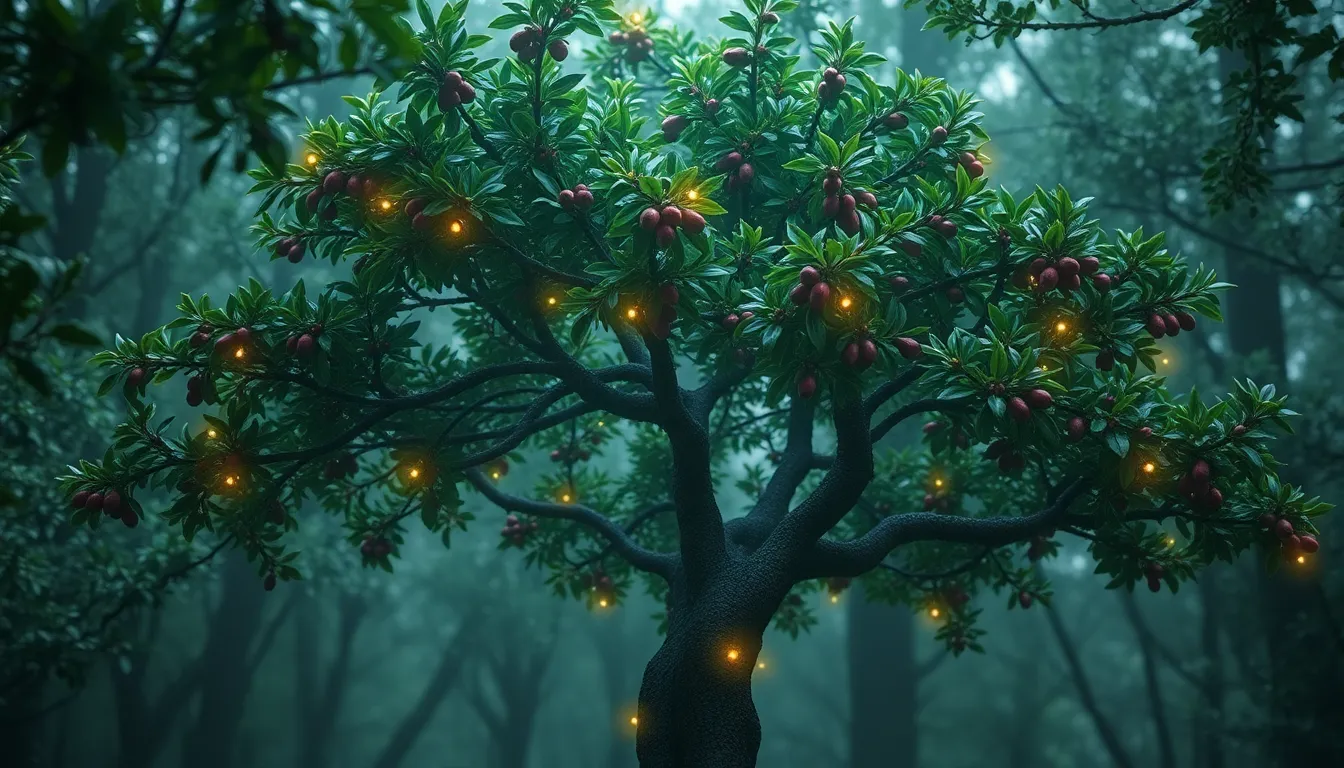The Mythical Holly: A Tree of Protection and Celebration
I. Introduction
The holly tree, with its vibrant green leaves and bright red berries, holds a unique place in the hearts and traditions of various cultures around the world. Revered for its beauty and symbolic meanings, holly has transcended time, embodying themes of protection and celebration. Throughout history, this evergreen has been associated with winter festivities, spiritual rituals, and a myriad of folklore that emphasize its protective qualities.
II. The Botanical Characteristics of Holly
A. Description of holly species and common varieties
Holly belongs to the genus Ilex, which boasts over 400 species worldwide. The most commonly recognized varieties include:
- Ilex aquifolium – Common holly, known for its spiny leaves and red berries.
- Ilex opaca – American holly, with glossy, spiny leaves and a broader leaf profile.
- Ilex crenata – Japanese holly, often used in landscaping due to its dense foliage.
B. Growth habitats and geographical distribution
Holly trees thrive in temperate regions, with their natural habitats ranging from the woodlands of Europe and Asia to the eastern United States. They prefer well-drained, acidic soils and can often be found in shaded or partially shaded areas. Holly is adaptable, allowing it to flourish in various climates, providing it with the right conditions.
C. Unique features: leaves, berries, and seasonal changes
One of the most distinctive features of holly is its leaves, which are typically dark green, glossy, and often serrated or spiny. The bright red berries, which appear in late autumn and winter, are not only beautiful but also serve a vital role in the ecosystem, attracting birds and other wildlife. During the fall, holly trees may also showcase a range of colors, from deep greens to vibrant yellows and reds as the leaves change, adding to their aesthetic appeal.
III. Historical Significance of Holly
A. Ancient beliefs and rituals surrounding holly
Throughout history, holly has been intertwined with various rituals and beliefs. Ancient Romans used holly during the Saturnalia festival, a time of revelry and celebration. Meanwhile, Druids considered holly a sacred plant, believing it had protective powers and was a symbol of eternal life.
B. Holly in folklore and mythology across different cultures
In many cultures, holly is associated with folklore depicting its magical properties. For instance, in European folklore, it was believed that bringing holly into the home would bring good luck and protect against misfortune. In Celtic mythology, holly was revered as a symbol of protection and was said to ward off evil spirits.
C. The role of holly in ancient medicine and healing practices
Holly has also been utilized in traditional medicine. The leaves and berries were often used in herbal remedies to treat ailments, such as fevers and respiratory issues. Although caution is advised due to the toxicity of holly berries in large quantities, the plant’s historical use emphasizes its significance in ancient healing practices.
IV. Holly as a Symbol of Protection
A. Folklore about holly warding off evil spirits
The belief that holly wards off evil spirits is prevalent in various cultures. People would hang holly above doorways and windows to protect their homes from malevolent forces, especially during the winter solstice.
B. Use of holly in protective charms and talismans
Holly has been used in protective charms and talismans, often worn or placed in homes to invoke safety. Its spiny leaves symbolize defense, while the red berries are thought to attract positive energy.
C. Holly in the context of home protection during winter months
During winter months, holly is often used to decorate homes, not only for its beauty but also for its symbolic protective qualities. Many believe that having holly in the home during this time of year brings warmth and safety against the harsh winter elements.
V. Holly in Seasonal Celebrations
A. Christmas and the symbolism of holly in winter festivities
Holly is perhaps most famously associated with Christmas. Its bright red berries and green leaves have become a staple in holiday decorations, symbolizing hope and renewal during the cold winter months. The use of holly in Christmas wreaths and garlands adds a festive touch to homes, embodying the spirit of the season.
B. Other cultural celebrations that incorporate holly
Beyond Christmas, holly plays a role in various cultural celebrations. For example, it is used in the celebration of the Winter Solstice, where its evergreen nature represents the triumph of life over death and the promise of spring.
C. The role of holly in modern holiday decorations and traditions
In modern times, holly continues to be a beloved element in holiday decorations. From Christmas trees adorned with holly to festive table settings featuring holly branches, its presence is a cherished tradition that connects generations.
VI. The Ecological Importance of Holly Trees
A. The role of holly in local ecosystems
Holly trees play a crucial role in local ecosystems. They provide habitat and shelter for various wildlife, including birds, insects, and small mammals. The dense foliage offers protection from predators and harsh weather conditions.
B. Benefits to wildlife: shelter and food sources
The berries of holly are a vital food source for birds and other wildlife during the winter months when food is scarce. Species such as robins, thrushes, and blackbirds often feast on the berries, making holly an essential component of their diet.
C. Conservation efforts for holly species
As urbanization and climate change pose threats to natural habitats, conservation efforts for holly species are increasingly important. Initiatives to plant native holly trees and protect existing populations are vital for maintaining biodiversity and ecological balance.
VII. Holly in Art and Literature
A. Representation of holly in visual arts and crafts
Holly’s striking appearance has inspired countless artists throughout history. From paintings to crafts, the imagery of holly evokes feelings of warmth and celebration, making it a popular subject during the winter months.
B. Symbolism of holly in poetry and prose
In literature, holly often symbolizes protection, resilience, and the enduring spirit of life. Poets and authors have employed holly as a metaphor for hope and renewal, capturing its essence in their works.
C. Modern interpretations of holly in contemporary media
In contemporary media, holly continues to be depicted in various forms, from holiday movies to advertisements, symbolizing the joy and warmth of the festive season. Its representation transcends generations, reminding us of tradition and celebration.
VIII. The Mystical Properties of Holly
A. Connection of holly with spiritual practices and rituals
Holly holds a special place in various spiritual practices. Many believe that it possesses protective and healing properties, making it a popular choice for rituals aimed at invoking peace and safety.
B. The significance of holly in various religions
In Christianity, holly is associated with the birth of Jesus, symbolizing his sacrifice and resurrection. In pagan traditions, it represents the god of the forest and is often used in rituals celebrating the changing of seasons.
C. Personal anecdotes and testimonials about the mystical experience with holly
Many individuals share personal stories of how holly has played a role in their spiritual journeys, whether through the creation of protective charms or the use of holly in seasonal rituals. These anecdotes highlight the enduring connection people have with this mythical tree.
IX. Cultivating Holly: Tips for Gardeners
A. Ideal conditions for planting and nurturing holly
To cultivate holly successfully, gardeners should consider the following conditions:
- Well-drained, acidic soil.
- Partial to full shade.
- Protection from strong winds.
B. Common pests and diseases affecting holly trees
Holly trees can be susceptible to various pests and diseases, including:




